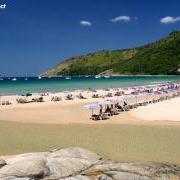
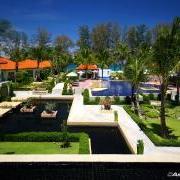
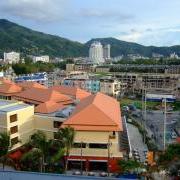
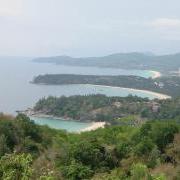
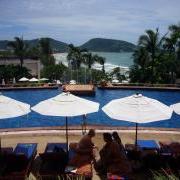
Welcome to Phuket and Patong Beach.
Patong Beach is the most popular and well-developed beach on Phuket Island. Long recognized as one of the world’s Top 10 diving sites, Phuket is now Thailand’s most important tourist destination, offering a variety of beaches, attractions and exciting night life.
Phuket Island has 17 sandy beaches.
Koh Phuket is Thailand’s largest Island. It is 50 km long north to south and 21 km wide and joined to the mainland by Sarasin bridge.
Phuket has been inhabited since the early days of mankind by ancient tribes and this still keeps archaeologists occupied to find out the history from the early days.
On the ancient maps of the region around Thailand’s South West coast, the name Junk Ceylon can be seen describing a way station on the route between India and China where seafarers stopped to shelter. This Island is today known as Phuket.
Phuket Island was assumed by geologists to be once part of the mainland in the form of a cape sticking out into the Andaman Sea but millions of years later the cape was gradually eroded by natural forces and finally detached from the main land.
One of the first known traces of Phuket is from a book written around the year 157 by Claudius Ptolemy, a famous Greek philosopher, that to travel to Malay Peninsula by ship, the travelers had to pass a cape known as Junk Ceylon. Located between latitudes 6 N and 8 N (which is the present site of Phuket Island), Junk Ceylon was at that time visited by merchants of several nations including India, Persia, and Arabia. The island offered a bay that protected its harbor from the wind and monsoon, making it a good stopover. Moreover, it had plenty of tin ore deposits that fetched high prices at that time.
A memorable moment in Phuket history was when a passing sea captain, Francis Light, sent word that the Burmese were en route to attack. Forces in Phuket were assembled led by the two heroines, Kunying Jan, Thao Thep Krasattri, wife of Phuket’s recently deceased governor, and her sister Mook, Thao Si Sunthon. There was a shortage of men so she allegedly ordered 500 women to dress as soldiers with coconut palms daubed in soot to look like weapons. This tactic seemed to delay a full-on Burmese attack. After a month’s siege the Burmese were forced to depart on 13 March, 1785. Kunying Jan and her sister were credited with the successful defense.
The Burmese attacked Phuket three more times between 1809-12 but armed forces from Bangkok arrived in time to repel further Burmese onslaughts. With Burma’s capitulation to the British, ensured that there would be no more Burmese invasions of Thailand.
During the Nineteenth Century Chinese immigrants arrived in such numbers to work for the tin mines that the ethnic character of the island’s interior became predominantly Chinese, while the coastal settlements remained populated essentially by Muslim fishermen.
In Rama V’s reign, Phuket became the administrative center of a group of tin mining provinces called Monton Phuket, and in 1933, with the change in government from absolute monarchy to a parliamentary system, the island was established as a province by itself.
It was not until 1967 that Sarasin Bridge was built to connect the main land with Phuket.
Tin mining industry has played a specially important rule in the economic development of the island province but it has declined especially after 1985 when the price of tin fell by half. Other important products of Phuket are marine products, latex, rubber, fuel oil and frozen fish.
With the opening of an international airport in 1976, Phuket effectively became a tourist economy. Over 4 million tourists arrived to Phuket in year 2002 and they spent about 72 billion baht on the island.
The permanent Island Population consists of a total of 292,245 (end 2005) with 140,703 males and 151,542 females. They consist of Thai-Buddhist, 71%; Muslim 25%; and Chao Le (Sea Gypsy) 4%. The majority of population live in Phuket town and at Patong Beach.
Thalang National Museum
If you want to learn more about the history of Phuket we recommend a visit to the Thalang National Museum. This museum was established in 1985 in Thalang just 200 meters from the Heroines Monument. Built in a southern architectural style, the museum exhibits the Battle of Thalang, the way of life, culture and history of Phuket and the South.
Patong Beach is a beach on Phuket’s west coast. It is the main tourist resort in Phuket and contains the centre of Phuket’s nightlife and cheap shopping on the island. The beach became popular with western tourists, especially Europeans, in the late 1980s. Numerous large hotels and chain hotels are located in Patong
Patong Beach is maybe more famous for its nightlife than the 2-kilometer beach that runs the entire length of Patong. Nightlife is centered on two main areas Bangla Road and Paradise Complex, with Bangla Road being predominantly straight and Paradise Complex being predominantly gay. Much mixing of the two scenes occurs due to Phuket Island’s tolerant nature.
On December 26, 2004, Patong Beach along with many other areas along the western coast of Phuket and Thailand were struck by a tsunami caused by the 2004 Indian Ocean earthquake. The wave caused a great deal of destruction to the waterfront of the beach although the destruction was not nearly as bad as nearby in Khao Lak. It took probably less than 6 months to rebuild 80% of what was destroyed and 1 year after you could hardly not see any traces of destruction caused by the Tsunami.
Patong Beach – History
Official permanent population is 14797 (2006) persons but the real number is probably as high as 60,000 in high season.
1827 Baan Kathu and Baan Patong are small villages without convenient transportation
1898 The Island is organized into five grades of local administration.
1947 The government approves 60,000 THB for a basic road over the hill to Patong
1969 Patong is upgraded to a “sanitation district” and taxes of 20,000 THB a year are collected.
1976 A sealed road is built to Patong.
1979 Electricity arrives
1994 Patong sanitation district is upgraded to a municipally
2004 Patong was hit by the Asian Tsunami 26 December
2005 Recovery year, tourism back to 80% at end of the year. Opening of Patong OTOP Shopping Paradise, Thanon Rat-U-Thit 200P (south end).
2006 Jungceylon, Patong’s first full-fledged modern air-con shopping mall, complete with 200 shops, integrated hotel, etc. Still under construction and the opening has been postponed several times, but will probably launch some time in end of 2006
Where to go to relax and rest:
- Baan Laimai Beach Resort
- The Vijitt Resort Phuket
- Movenpick Resort Bangtao Beach Phuket
- The Royal Phuket Yacth Club Hotel
- La Flora Resort Phatong
- The Kee Resort and Spa
- Anchalle Inn Hotel
- Andaman White Beach Resort
- The Grand Orchid Inn
- Bliss Botique Hotel
- Elixir Resort
- Phatong Beach Lodge
- Simplitel Hotel
- Horizon Karon Beach Hotel & Spa
- Evason Phuket and Bon Island Hotel
- Amarin Residence Patong Beach
- The Nap Patong Hotel
- Millenium Resort
- R Mar Resort and Spa
- Best Western Phuket Ocean Resort
Where to go for foods:
- Da Maurizio Bar Ristorante
- Baan Rimpa
- JOES Downstairs
- IndioChine Waterfront Restaurant
- Cudos Restaurant and Bar
- Taste Restaurant
- Bangtao Beach Restaurants
- Chalong, Nai Harn & Cape Panwa
- Kamala Beach Restaurants
- Karon Beach Restaurants
- Kata Beach Restaurants
- Patong Beach Restaurants
- Phuket Town Restaurants
- Surin Beach Restaurants
Where to go for medical needs:
- Phuket International Hospital

